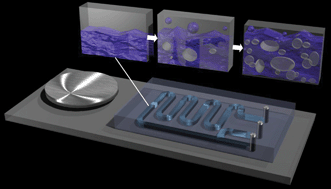Creation of cavitation activity in a microfluidic device through acoustically driven capillary waves†
Abstract
We present a study on achieving intense acoustic cavitation generated by ultrasonic vibrations in polydimethylsiloxane (PDMS) based microfluidic devices. The substrate to which the PDMS is bonded was forced into oscillation with a simple piezoelectric transducer attached at 5 mm from the device to a microscopic glass slide. The transducer was operated at 100 kHz with driving voltages ranging between 20 V and 230 V. Close to the glass surface, pressure and vibration amplitudes of up to 20 bar and 400 nm were measured respectively. It is found that this strong forcing leads to the excitation of nonlinear surface waves when gas–liquid interfaces are present in the microfluidic channels. Also, it is observed that nuclei leading to intense inertial cavitation are generated by the entrapment of gas pockets at those interfaces. Subsequently, cavitation bubble


 Please wait while we load your content...
Please wait while we load your content...